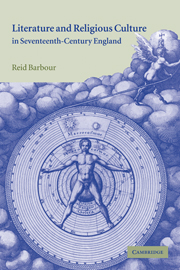Book contents
- Frontmatter
- Contents
- Acknowledgements
- Introduction: spirit and circumstance in Caroline Protestantism
- Chapter 1 The church heroic: Charles, Laud, and Little Gidding
- Chapter 2 Great Tew and the skeptical hero
- Chapter 3 Between liturgy and dreams: the church fanciful
- Chapter 4 Respecting persons
- Chapter 5 Decorum and redemption in the theater of the person
- Chapter 6 Nature (I): post-Baconian mysteries
- Chapter 7 Nature (II): church and cosmos
- Conclusion: Rome, Massachusetts, and the Caroline Protestant imagination
- Notes
- Index
Introduction: spirit and circumstance in Caroline Protestantism
Published online by Cambridge University Press: 22 September 2009
- Frontmatter
- Contents
- Acknowledgements
- Introduction: spirit and circumstance in Caroline Protestantism
- Chapter 1 The church heroic: Charles, Laud, and Little Gidding
- Chapter 2 Great Tew and the skeptical hero
- Chapter 3 Between liturgy and dreams: the church fanciful
- Chapter 4 Respecting persons
- Chapter 5 Decorum and redemption in the theater of the person
- Chapter 6 Nature (I): post-Baconian mysteries
- Chapter 7 Nature (II): church and cosmos
- Conclusion: Rome, Massachusetts, and the Caroline Protestant imagination
- Notes
- Index
Summary
In the decades of the 1620s, 30s, and 40s, authors attempting to secure English Protestant orthodoxy against its critics undertook something more daring in the process: a rich and complex inquisition into the wide cultural constituents of religious experience itself. By and large, these writers were less interested in articulating a core of doctrine than they were in exploring and testing the very conditions in which their faith was imagined, situated, and lived. From the publication of Bacon’s last works in the 1620s to the culmination of the Civil War in 1648, a spectrum of writers took stock of what they tend to call the “circumstances” of their faith, a term that ranges in meaning from the “pomp and circumstance” of religious heroism and ritual to the analysis of the modes of reverential thought itself. In these years, the term “circumstance” was applied to the spiritual, social, and legal constituents of a “person” as well as the cosmic or natural order enveloping a person. Carried out in print, in small communities, from the pulpit, on stage, and at court, the Caroline reexamination of English Protestant orthodoxy certainly generated its own versions of dogmatism, but its main tendencies leaned toward the intensive, probing scrutiny of the matrix of religious experience, lending support to Thomas Browne's contention that dogmatic appearances notwithstanding, “the wisest heads prove at last, almost all Scepticks.”
- Type
- Chapter
- Information
- Publisher: Cambridge University PressPrint publication year: 2001

